Antibody data
- Antibody Data
- Antigen structure
- References [3]
- Comments [0]
- Validations
- Immunocytochemistry [2]
- Immunohistochemistry [3]
- Other assay [3]
Submit
Validation data
Reference
Comment
Report error
- Product number
- PA5-29102 - Provider product page

- Provider
- Invitrogen Antibodies
- Product name
- WARS Polyclonal Antibody
- Antibody type
- Polyclonal
- Antigen
- Recombinant protein fragment
- Description
- Recommended positive controls: HepG2, mouse brain. Predicted reactivity: Mouse (94%), Rat (93%), Zebrafish (86%), Xenopus laevis (89%), Rabbit (93%), Chimpanzee (100%), Bovine (97%). Store product as a concentrated solution. Centrifuge briefly prior to opening the vial.
- Reactivity
- Human, Mouse, Rat
- Host
- Rabbit
- Isotype
- IgG
- Vial size
- 100 μL
- Concentration
- 1 mg/mL
- Storage
- Store at 4°C short term. For long term storage, store at -20°C, avoiding freeze/thaw cycles.
Submitted references Neuropilin 1 and its inhibitory ligand mini-tryptophanyl-tRNA synthetase inversely regulate VE-cadherin turnover and vascular permeability.
Tryptophanyl-tRNA Synthetase Sensitizes Hormone Receptor-Positive Breast Cancer to Docetaxel-Based Chemotherapy.
Context-enriched interactome powered by proteomics helps the identification of novel regulators of macrophage activation.
Gioelli N, Neilson LJ, Wei N, Villari G, Chen W, Kuhle B, Ehling M, Maione F, Willox S, Brundu S, Avanzato D, Koulouras G, Mazzone M, Giraudo E, Yang XL, Valdembri D, Zanivan S, Serini G
Nature communications 2022 Jul 20;13(1):4188
Nature communications 2022 Jul 20;13(1):4188
Tryptophanyl-tRNA Synthetase Sensitizes Hormone Receptor-Positive Breast Cancer to Docetaxel-Based Chemotherapy.
Lee KM, Hwang EH, Kang SE, Lee CH, Lee H, Oh HJ, Kim K, Koh J, Ryu HS
Journal of breast cancer 2020 Dec;23(6):599-609
Journal of breast cancer 2020 Dec;23(6):599-609
Context-enriched interactome powered by proteomics helps the identification of novel regulators of macrophage activation.
Halu A, Wang JG, Iwata H, Mojcher A, Abib AL, Singh SA, Aikawa M, Sharma A
eLife 2018 Oct 10;7
eLife 2018 Oct 10;7
No comments: Submit comment
Supportive validation
- Submitted by
- Invitrogen Antibodies (provider)
- Main image
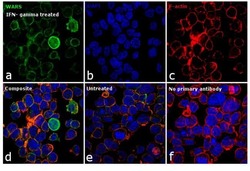
- Experimental details
- Immunofluorescence analysis of WARS was performed using 70% confluent log phase THP-1 cells treated with IFN-gamma (100 units/mL for 24h). The cells were fixed with 4% paraformaldehyde for 10 minutes, permeabilized with 0.1% Triton™ X-100 for 15 minutes, and blocked with 1% BSA for 1 hour at room temperature. The cells were labeled with WARS Polyclonal Antibody (Product # PA5-29102) at 1:100 dilution in 0.1% BSA, incubated at 4 degree Celsius overnight and then labeled with Goat anti-Rabbit IgG (H+L) Superclonal™ Secondary Antibody, Alexa Fluor® 488 conjugate (Product # A27034) at a dilution of 1:2000 for 45 minutes at room temperature (Panel a: green). Nuclei (Panel b: blue) were stained with SlowFade® Gold Antifade Mountant with DAPI (Product # S36938). F-actin (Panel c: red) was stained with Rhodamine Phalloidin (Product # R415, 1:300). Panel d represents the merged image showing increased expression of WARS in the cytoplasm. Panel e represents the untreated control. Panel f represents control cells with no primary antibody to assess background. The images were captured at 60X magnification.
- Submitted by
- Invitrogen Antibodies (provider)
- Main image
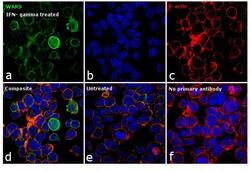
- Experimental details
- Immunofluorescence analysis of WARS was performed using 70% confluent log phase THP-1 cells treated with IFN-gamma (100 units/mL for 24h). The cells were fixed with 4% paraformaldehyde for 10 minutes, permeabilized with 0.1% Triton™ X-100 for 15 minutes, and blocked with 1% BSA for 1 hour at room temperature. The cells were labeled with WARS Polyclonal Antibody (Product # PA5-29102) at 1:100 dilution in 0.1% BSA, incubated at 4 degree Celsius overnight and then labeled with Goat anti-Rabbit IgG (Heavy Chain) Superclonal™ Secondary Antibody, Alexa Fluor® 488 conjugate (Product # A27034) at a dilution of 1:2000 for 45 minutes at room temperature (Panel a: green). Nuclei (Panel b: blue) were stained with SlowFade® Gold Antifade Mountant with DAPI (Product # S36938). F-actin (Panel c: red) was stained with Rhodamine Phalloidin (Product # R415, 1:300). Panel d represents the merged image showing increased expression of WARS in the cytoplasm. Panel e represents the untreated control. Panel f represents control cells with no primary antibody to assess background. The images were captured at 60X magnification.
Supportive validation
- Submitted by
- Invitrogen Antibodies (provider)
- Main image
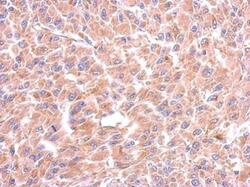
- Experimental details
- Immunohistochemical analysis of paraffin-embedded U87 xenograft, using Tryptophanyl tRNA synthetase (Product # PA5-29102) antibody at 1:500 dilution. Antigen Retrieval: EDTA based buffer, pH 8.0, 15 min.
- Submitted by
- Invitrogen Antibodies (provider)
- Main image
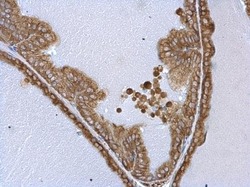
- Experimental details
- WARS Polyclonal Antibody detects Tryptophanyl tRNA synthetase protein at cytosol on mouse prostate by immunohistochemical analysis. Sample: Paraffin-embedded mouse prostate. WARS Polyclonal Antibody (Product # PA5-29102) dilution: 1:500. Antigen Retrieval: EDTA based buffer, pH 8.0, 15 min.
- Submitted by
- Invitrogen Antibodies (provider)
- Main image
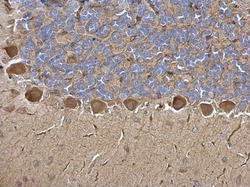
- Experimental details
- WARS Polyclonal Antibody detects Tryptophanyl tRNA synthetase protein at cytosol on rat hind brain by immunohistochemical analysis. Sample: Paraffin-embedded rat hind brain. WARS Polyclonal Antibody (Product # PA5-29102) dilution: 1:500. Antigen Retrieval: EDTA based buffer, pH 8.0, 15 min.
Supportive validation
- Submitted by
- Invitrogen Antibodies (provider)
- Main image
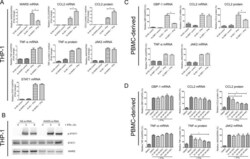
- Experimental details
- Figure 5. In vitro loss-of-function experiments for GBP1 and WARS. ( A ) Relative mRNA and protein expression levels for CCL2, TNFalpha, JAK2 and STAT1 and with WARS silencing under control and IFNgamma stimulation conditions, performed on THP-1-differentiated macrophage-like cells.(n = 8-12 samples from three to four experiments) ( B ) Western blot showing protein expression levels of pSTAT1 with WARS silencing under control and IFNgamma stimulation conditions, performed on THP-1-differentiated macrophage-like cells. Data shown as representative image from three experiments ( C ) Relative mRNA and protein expression levels of CCL2, TNFalpha and JAK2 with GBP1 silencing under control and IFNgamma stimulation conditions, performed on human primary PBMC-derived macrophages (n = 9-12 samples from four human donors). ( D ) Relative mRNA and protein expression levels for CCL2, TNFalpha, and JAK2 under treatment with NSC756093, a GBP1-PIM1 inhibitor, in human PBMC-derived macrophages (n = 7-10 samples from four human donors) stimulated with IFNgamma for 24 hr. mRNA expression levels were measured by RT-PCR and normalized by GAPDH expression. Protein in culture media was detected by ELISA. In all figures, *p
- Submitted by
- Invitrogen Antibodies (provider)
- Main image
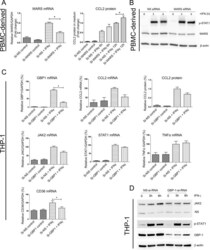
- Experimental details
- Figure 5--figure supplement 1. ( A ) Protein expression level of CCL2 with WARS silencing under control and IFNgamma stimulation conditions, performed on human primary PBMC-derived macrophages. *p
- Submitted by
- Invitrogen Antibodies (provider)
- Main image
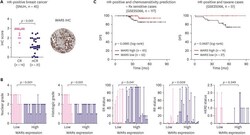
- Experimental details
- Figure 1 Association between WARS expression and chemotherapy response in HR-positive breast cancer. (A) Representative graphs of IHC score between nCR and CR groups in HR-positive breast cancer patients who received neoadjuvant chemotherapy (SNUH cohort, n = 45, left). Representative images of IHC staining using WARS antibody (x200). (B) Representative graphs show the clinicopathologic characteristics (nuclear grade, histologic grade, ER status, PR status, and HER2 status) in relation to WARS expression. The p -values were calculated using the 2-sided Student's t -test and Mann-Whitney U test (HER2 status). (C) Kaplan-Meier plot of DFS based on WARS expression in HR-positive breast cancer cohort (GSE25066) who received chemotherapy (n = 117, left) and taxane (n = 51, right). WARS = tryptophanyl-transfer RNA synthetase; HR = hormone receptor; IHC = immunohistochemistry; CR = complete response; nCR = non-complete response; SNUH = Seoul National University Hospital; DFS = disease-free survival.
 Explore
Explore Validate
Validate Learn
Learn Western blot
Western blot Immunocytochemistry
Immunocytochemistry